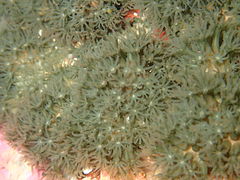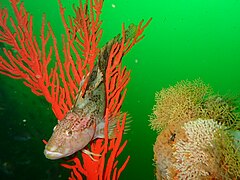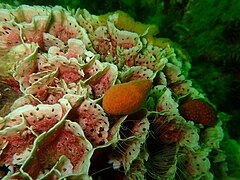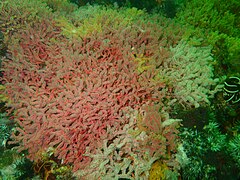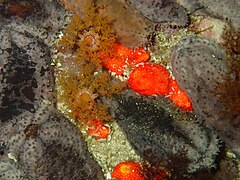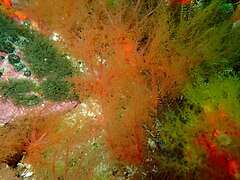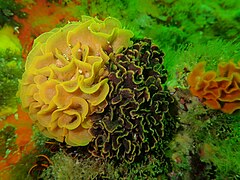The dive site Drop Zone is an offshore rocky reef in the north western False Bay, near Strand in the Western Cape province of South Africa.
Understand
edit
This site has a comfortable range of depths for recreational diving, and is reasonably close to the slipways at Gordon's Bay, while being far enough offshore to have a fair chance of better visibility when visibility is poor at the shoreline sites of eastern False Bay. Biodiversity is fairly high and the site is large.
Position
editS34°08.561' E18°45.829' 1 Drop Zone About 8.6 km west (276°true) of Harbour Island. This site is not in a Marine Protected Area. A permit is not required.
Name
editThe name "Drop Zone" was given to the site by Indigo Divers of Gordons Bay.
Depth
editMaximum depth is about 26 m, and the top of the reef is about 12 m according to the official charts. Average depth is likely to be about 18 m.
Visibility
editVisibility on the east side of False Bay is generally worse than on the Cape Peninsula, but Drop Zone is sufficiently offshore to be unaffected by most rain runoff and deep enough to be relatively unaffected by swell, particularly as it is quite a large area without much sand or silt. On the other hand, it will not have the advantage of upwelling clear water in an offshore wind. Plankton blooms may reduce visibility in the upper layers while visibility at depth remains relatively good, though fairly dark. This can only be determined by diving. Visibility has been recorded at about 10 m, but may often be less.
Topography
editModerate and low profile high rugosity rocky reef. The very steep dip results in many ridges and gullies, mostly mot very deep. There are few landmarks of note.
Geology: Hard, resistant, sedimentary rock, possibly of the Precambrian Tygerberg formation. Strike NW-SE, Dip nearly vertical.
Conditions
editThe site is exposed to wind from all directions and swell from most, so should be dived in low swell and light winds. The site is reasonably protected from south easterly swell, but if strong south easterly winds develop then the ride back to Gordon's Bay will be wet and bumpy
There is no preferred season for diving this site: local weather and ocean swell conditions will have the most influence. Avoid big southerly or south westerly swell.
Get in
editBoat access only, The site is a considerable distance offshore.
The site is about 8.6 km from Harbour Island slipway, or 9.2 km from Gordon's Bay Old Harbour
See
editMarine life
editLarge numbers of gorgonian sea fans, shoals of juvenile fish, and the usual variety of echinoderms, sponges and anemones. Not much seaweed, which suggests that the reef is not exposed to much light, which means that the visibility is not often very good. In 2014, it was free of the massive brittlestar populations common on the Cape Peninsula sites.
- Olive soft coral
- Striped anemone Anthothoe chilensis
- Highfin klipfish on Palmate sea fan
- Basket star Astrocladus euryale
- Papery burnupena on lacy false coral
- Multicolour sea fan
- Red chested and Mauve sea cucumbers
- Black nudibranch
- Golden sea cucumbers
- Scrolled false corals
Photography
editAs a general rule, visibility is unlikely to be great, with fairly large particulates, natural light will be relatively poor, and there are no major features, so macro photography and close-up wide angle with external flash are likely to produce the best results.
Suggested routes
editThe site is very large, and no one area is greatly different from the others. Explore if it suits you, but there is no particular reason to go very far from the shotline.
Stay safe
editHazards
editNo known site-specific hazards, though if the south-easterly wind comes up strongly it may be difficult for the boat crew to spot divers at the surface, and impossible to follow bubbles.
Skills
editCompetence at buoyancy control to avoid impacting the fragile bryozoan colonies.
Equipment
editA DSMB is recommended to show the boat where you are while ascending, and after surfacing if the wind comes up. There are few landmarks, so if you want to navigate with any reliability, take a compass.
Nearby
editOther offshore dive sites of False Bay:
- 1 Choirboys Reef
- 2 Seal Island
- 3 East Shoal
- 4 Moddergat
- 5 Sterretjies Reef
- 6 York Shoal
- 7 SAS Fleur
- 8 Offshore Barges – North Barge
- 9 Steenbras Deep - South Pinnacles
- 10 Blue Flame Pinnacles
- 11 SATS General Botha
- 12 Off-Whittle Ridge
- 13 SAS Bloemfontein
- 14 Whittle Rock
- 15 Bruce's Mark
- 16 Deep South Whittle Reef
- 17 Anvil Rock
- 18 SS Lusitania
- 19 Rocky Bank
Back to the Alphabetical list of sites, or list of reef dive sites in the northern False Bay offshore area
Other regional dive sites:
- Dive sites of Table Bay and approaches,
- Dive sites of the Cape Peninsula west coast
- Dive sites of the Cape Peninsula east coast
- Dive sites of False Bay east coast
- Fresh water dive sites of the Cape Town Metropolitan Area

